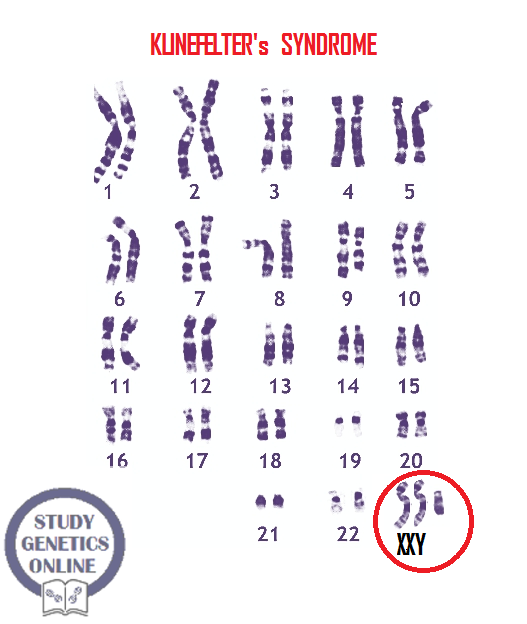Chromosomes are of two main types such as autosomes and sex chromosomes. Karyotyping is a cytogenetic technique used to detect an abnormal number of chromosomes. A photomicrograph of chromosomes reveals the actual status of the individual. An abnormal number of autosomes leads to monosomies and trisomies. An abnormal number of sex chromosomes lead to respective conditions. Thus, representation of a karyotype depends on the number of chromosomes. Various conditions arise due to an abnormal number of X and Y chromosomes. Mosaicism may also arise due to an abnormal number of sex chromosomes. Conditions such as trisomies, monosomies, and mosaicism arise due to numerical abnormalities.
Turner syndrome:
The karyotype of a turner female is 45, XO. In this syndrome, an X chromosome is missing. It is a condition associated with monosomy. Repeated spontaneous abortions arise due to monosomies. Clinical features of turner females include the webbed neck, small breast size, heart defects, rudimentary ovaries, and slight mental retardation. Infertility is very high in these females. Secondary sexual characteristics are underdeveloped. Hence they undergo Estrogen replacement therapy. Aneuploidy is common in such individuals. It leads to an extra copy or a missed chromosome leading to an unbalanced chromosome complement. Thus, their genomic complement is 45, XO or 45 X.
A majority of 45, X embryos die before birth. Some of the genes are involved in controlling characteristics other than sexual characteristics. A gene involved in bone development in turner females is known as SHOX gene. A copy of this gene is not present in the affected individuals. Hence, turner females exhibit short stature and skeletal abnormalities.
Image 1: Karyotype revealing Turner's syndrome (45, XO)
Klinefelter syndrome:
This syndrome affects males. The karyotype of Klinefelter’s syndrome is 47, XXY. It occurs in 1 per 1000 newborn males. If not detected earlier the affected individual and his family members may not even know about the condition. The body of a Klinefelter male may slightly appear like that of a female with wide hips, breasts, small testis and poor growth of the beard. Secondary sexual characteristics in Klinefelter individuals are underdeveloped accompanying mosaicism. These individuals exhibit the presence of a Barr body. They have to undergo a hormone treatment such as testosterone therapy. An egg or a sperm cell may gain an extra X chromosome due to non-disjunction. Mother’s age may be responsible for the non-disjunction. Pregnancy above 35 years of age imposes a great risk of developing this syndrome in the embryo. Mosaic Klinefelter syndrome arises due to an extra X chromosome in some cells and a normal XY complement in other cells. Klinefelter boys have very low energy, low self-esteem, shyness, and problems in reading and writing. In their later years of life, such individuals also experience erectile dysfunction and low sex drive.
Image 2: Karyotype revealing Klinefelter's syndrome (47, XXY)
47, XXX females (Triple X syndrome):
It happens with 0.1 % cases of females. They are phenotypically normal with less or moderate I.Q. and reproductive life. Trisomy X is diagnosed using chromosome analysis (karyotyping). It reveals an extra copy of the X chromosome. FISH may help to detect the condition in detail.
47, XYY Males:
These males exhibit the presence of two Y chromosomes. They are phenotypically normal. However, they are abnormally tall and show slight mental retardation. Such individuals show emotional immaturity. Presence of an additional Y chromosome is due to non-disjunction in meiosis II during spermatogenesis. This syndrome is also known as Jacob’s syndrome or YY syndrome. Chromosomal analysis may help to detect this problem. Jacob’s syndrome arises due to an error in cell division in the sperm before conception.
48, XXXX syndrome:
This condition is also known as Tetrasomy X or a quadruple X syndrome which is an extremely rare disorder in the females. It arises due to aneuploidy or defects in the meiosis. The homologous chromosomes fail to separate in forming sperms or eggs. Karyotyping and FISH help to detect this condition.
48, XXXY syndrome:
It is a variant of Klinefelter syndrome accompanying hypotonia and hypogonadism. Random errors in cell division are common in this case. This condition may not be necessarily inherited.
48, XXYY syndrome:
The affected males experience infertility, deep vein thrombosis, learning disabilities, and underdeveloped reproductive system. Testosterone is not adequately synthesized.
49, XXXXY syndrome:
They are males with completely undeveloped or absent sperms. They exhibit hypogonadism with micropenis and cryptorchidism. It is an extremely rare condition.
49, XXXXX syndrome:
It is known as Pentasomy X and associated with developmental delays, physical and mental abnormalities. The phenotype is that of a female with an abnormal number of X chromosomes. Problems in parental reproductive cells give rise to pentasomy X.
Gonadal dysgenesis:
It is of two main types such as XY and XX gonadal dysgenesis. The XY gonadal dysgenesis is known as Swyer syndrome and characterized by hypogonadism. A person’s phenotype is that of a female. However, there is no puberty. They show the presence of streak gonads. Internal male organs are not well developed. XX gonadal dysgenesis is a kind of female hypogonadism. However, XX gonadal dysgenesis affects both males and females. They show poor growth of secondary sexual characteristics and low Estrogen levels. Some references report mutations in mitochondrial tRNA synthetase. Perrault syndrome accompanies this syndrome along with deafness.
XX Male syndrome:
The genotype of a female is normal. However, the phenotype is like a male. This condition arises due to unequal crossing over between an X and Y chromosome during meiosis. The X chromosome consists of SRY gene from the father’s Y chromosome. It is also known as De la Chapelle syndrome.
References:
[1] Vogel and Motulsky's Human Genetics, Friedrich Vogel, Gunter Vogel, Arno G.
[2] Gardner and Sutherland's Chromosome Abnormalities and Genetic Counseling
By R.J. McKinlay Gardner, David Amor
References:
[1] Vogel and Motulsky's Human Genetics, Friedrich Vogel, Gunter Vogel, Arno G.
[2] Gardner and Sutherland's Chromosome Abnormalities and Genetic Counseling
By R.J. McKinlay Gardner, David Amor
© Copyright, 2018 All Rights Reserved.






